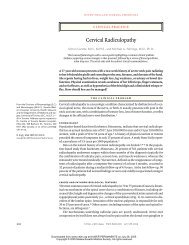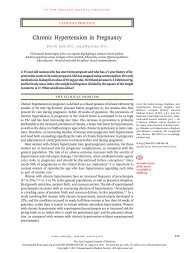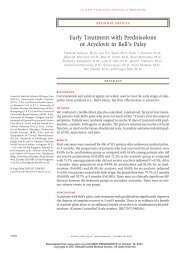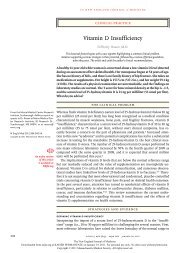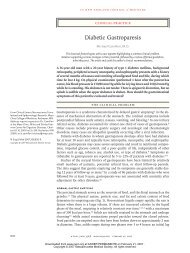Hypoparathyroidism - Q-Notes for Adult Medicine
Hypoparathyroidism - Q-Notes for Adult Medicine
Hypoparathyroidism - Q-Notes for Adult Medicine
You also want an ePaper? Increase the reach of your titles
YUMPU automatically turns print PDFs into web optimized ePapers that Google loves.
clinical practice<br />
Resistance to PTH action‡<br />
Pseudohypoparathyroidism Bastepe 24<br />
Type 1a Clinical features include AHO (round facies, mental retardation, frontal bossing, short stature, obesity,<br />
brachydactyly, ectopic ossifications), hypocalcemia, hyperphosphatemia, and elevated PTH levels; hypothyroidism<br />
develops in a majority of patients because of thyrotropin resistance and less frequently<br />
hypogonadism occurs as a result of gonadotropin resistance; autosomal dominant inheritance pattern<br />
with maternal transmission of the biochemical phenotype; blunted urinary cyclic AMP response to administration<br />
of PTH; a majority of patients have heterozygous inactivating mutations in the gene encoding<br />
the G s -α subunit protein (the GNAS gene)<br />
Type 1b No features of AHO, but same biochemical features as pseudohypoparathyroidism type 1a, including<br />
blunted urinary cyclic AMP response to administration of PTH; caused by selective resistance to PTH<br />
(not to other hormones) and by imprinting defects in GNAS<br />
Type 2 Less common than pseudohypoparathyroidism type 1a or 1b but with same biochemical profile; inherited<br />
or sporadic occurrence; cause of PTH resistance is unclear; patients have normal urinary cyclic AMP<br />
but no phosphaturic responses to PTH<br />
* AHO denotes Albright’s hereditary osteodystrophy, CaSR extracellular calcium-sensing receptor, GCMB glial cells missing B, GCM2 glial cells missing 2, and PTH parathyroid hormone.<br />
† The frequency of each of the diagnoses is difficult to establish because there are few large contemporary series of patients. The three most common causes appear to be postsurgical<br />
hypoparathyroidism, autoimmune polyendocrine syndrome type 1, and autosomal dominant hypocalcemia due to activating CaSR mutations. 4<br />
‡ Resistance lies in the pathway that couples receptor activation to the effector adenylate cyclase. These disorders must be considered in the initial evaluation of patients with hypocalcemia,<br />
especially if hyperphosphatemia is present. Once the intact PTH value is shown to be elevated and vitamin D deficiency or resistance is ruled out, the diagnosis of resistance to<br />
PTH action (not impaired PTH secretion) is established.<br />
parathyroidism and in vitamin D deficiency. In<br />
patients with hypocalcemia due to activating mutations<br />
in the extracellular calcium-sensing receptor,<br />
the ratio of 24-hour urinary calcium to creatinine<br />
has been reported to be substantially<br />
higher than in patients with other types of hypoparathyroidism<br />
(mean value in one report, 0.362<br />
vs. 0.093) and more like that in controls with<br />
normocalcemia (mean value, 0.331). 12<br />
If magnesium deficiency is detected, it is useful<br />
to measure the 24-hour urinary magnesium<br />
level be<strong>for</strong>e repletion is initiated. Elevated or<br />
even detectable urinary levels of magnesium suggest<br />
renal losses as the cause of magnesium depletion,<br />
since the kidney should conserve magnesium<br />
when body stores are depleted (Table 1).<br />
Specialized testing (available in hospital or<br />
reference laboratories) may be warranted to establish<br />
the cause of hypoparathyroidism. This<br />
testing may include gene sequencing <strong>for</strong> the extracellular<br />
calcium-sensing receptor, GATA3, or<br />
the autoimmune regulator protein; microarray<br />
studies or fluorescence in situ hybridization to<br />
diagnose the DiGeorge syndrome; and other hormone<br />
measurements to diagnose autoimmune<br />
polyendocrine syndrome type 1. In many cases,<br />
referral to a pediatric or adult endocrinologist or<br />
geneticist is indicated.<br />
Treatment and Clinical Monitoring<br />
The goals of therapy are to control symptoms<br />
while minimizing complications. The urgent care<br />
of patients with hypocalcemia should be guided<br />
by the nature and severity of the symptoms and<br />
the level of serum calcium. 46,48-51 Severe symptoms<br />
(e.g., seizures, laryngospasm, bronchospasm,<br />
cardiac failure, and altered mental status)<br />
warrant intravenous calcium therapy, even if the<br />
serum calcium level is only mildly reduced (e.g.,<br />
7.0 to 8.0 mg per deciliter [1.75 to 2.00 mmol per<br />
liter]). In such cases, the decrease in the serum<br />
calcium level may have precipitated the symptoms,<br />
and patients usually have immediate, substantial<br />
relief of symptoms with intravenous therapy<br />
(Table 3). Patients with congestive heart failure<br />
due to chronic hypocalcemia require additional<br />
medical treatment (e.g., supplemental oxygen and<br />
diuretics). Intravenous calcium therapy is also recommended<br />
in such patients, even though cardiac<br />
symptoms may resolve more slowly.<br />
Intravenous calcium injections raise the level<br />
of serum calcium transiently; continuous infu-<br />
n engl j med 359;4 www.nejm.org july 24, 2008 395<br />
Downloaded from www.nejm.org at KAISER PERMANENTE on July 23, 2008 .<br />
Copyright © 2008 Massachusetts Medical Society. All rights reserved.






